
- Presenters:
- Scott DiStefano | Mrs. Eri Vokshi
- Duration:
- 18 Minutes
- Format:
- Audio and Video
- License:
- Access for 6 month(s) after purchase.
- Short Description:
- The installation of externally applied FRP systems has been slow to evolve due to limitations of materials used in the field. This demonstration will show how to make the most out of the materials with efficient application methods that will save time and money.
- Price:
- $0.00 - $5.00
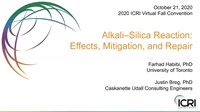
- Presenters:
- Dr. Farhad Habibi, PhD | Justin Breg, PhD
- Duration:
- 36 Minutes
- Format:
- Audio and Video
- License:
- Access for 6 month(s) after purchase.
- Short Description:
- Alkali-Silica Reaction (ASR) can cause significant damage to concrete structures including bridges, roadways, airport runways, and nuclear power plants. When reactive aggregates are included in a mix, the presence of moisture initiates a reaction between the alkaline cement paste and reactive amorphous silica. The result is a gel that continues to dilate, which may cause cracks in the concrete mass. A research program was undertaken at the University of Toronto to investigate the effects of ASR on large-scale and small-scale concrete specimens. Several specimens were constructed using reactive (ASR) concrete and non-reactive (regular) concrete, and their short-term and long-term structural and mechanical behavior were compared. In this presentation, we will discuss the results of the research program, will offer best practices to minimize the risk of ASR in concrete during placement, and will propose several strategies for repair of structures that have been degraded due to ASR.
- Price:
- $0.00 - Base Price
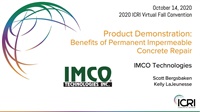
- Presenters:
- Mr. Scott Bergsbaken | Mr. Kelly LaJeunesse
- Duration:
- 10 Minutes
- Format:
- Audio and Video
- License:
- Access for 6 month(s) after purchase.
- Short Description:
- How to properly mix, place and finish MG-Krete, a 2-component product and permanent repair material, will be demonstrated. The demonstration will show methodologies employed in horizontal, vertical, overhead and structural repairs using MG-Krete. Participants will learn the chemistry behind the product and the reason why it is a successful permanent repair material. There will be a full technical review of the product benefits.
- Price:
- $0.00 - $5.00
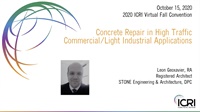
- Presenters:
- Mr. Leon Geoxavier
- Duration:
- 29 Minutes
- Format:
- Audio and Video
- License:
- Access for 6 month(s) after purchase.
- Short Description:
- High Traffic Commercial/Light Industrial applications including light manufacturing, warehouse/big-box stores and high traffic retail applications present their own unique challenges in concrete repair. This presentation will review concrete repair options that a focused on those application that may require both fast application/turnaround time and strength/use durability for forklifts and trucks. High Traffic Commercial/Light Industrial applications including light manufacturing, warehouse/big-box stores and high traffic retail applications present their own unique challenges in concrete repair. This presentation will review concrete repair options that a focused on those application that may require both fast application/turnaround time and strength/use durability for forklifts and trucks. While there are many option for quick repair that can be open to use in a matter of hours, it is important to acknowledge he potential limitations of these options over the long term.
- Price:
- $0.00 - Base Price

- Presenters:
- Brian Mintz | Juan Bedoya
- Duration:
- 14 Minutes
- Format:
- Audio and Video
- License:
- Access for 6 month(s) after purchase.
- Short Description:
- Phoscrete is an easy-to-use, fast-setting, long-lasting Magnesium-Alumina-Liquid-Phosphate (MALP) concrete repair material for repairs in extreme environments (-15°F to +115°F). Instead of water, Phoscrete’s pre-extended dry component mixes include Liquid Phosphate Activator (Freezing Point = -20°F). Working time and set time are easily controlled by supercooling the activator in hot temperatures, and by adding fast-set admixtures in cold temperatures. The presentation will include laboratory testing, field installation, and a small installation.
- Price:
- $0.00 - $5.00

- Presenters:
- Marthe Brock
- Duration:
- 50 Minutes
- Format:
- Audio and Video
- License:
- Access for 6 month(s) after purchase.
- Short Description:
- From the days of boiled Linseed oil, to the discovery of membrane forming cures, to the development of carbon dioxide injection; curing has evolved to accommodate the demands of the construction industry. This presentation will look back at the early standards developed by ASTM, contrasting them to the standards that are currently under consideration. There are many ways to cure concrete, this presentation will review the various product options framed in the context of weather. Lastly, the presentation will explore the various methods discussing the features and benefits of the common curing practices of today.
- Price:
- $0.00 - Base Price
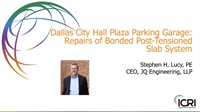
- Presenters:
- Stephen Lucy
- Duration:
- 49 Minutes
- Format:
- Audio and Video
- License:
- Access for 6 month(s) after purchase.
- Short Description:
- Dallas City Hall and Plaza are recognized by many due to the opening scenes of Dallas, the television show. What is less known is that the structure is a significant early example of bonded post-tensioned concrete which was utilized throughout the superstructure and two-story parking garage constructed beneath the plaza. Opened in 1977, the parking garage is a two-way bonded post-tensioned concrete slab with unreinforced drop panels supported by flared circular concrete columns. The garage covers two city blocks, extends under two adjacent multi-lane streets, and supports mature landscaping, pool, fountain, and up to 11’-0” of soil. In 2017, several square feet of a drop panel fell from the structure and subsequent observations found multiple locations of drop panel and column capital failures. A structural investigation including destructive and non-destructive testing, and analysis of the existing structure was undertaken to determine the cause of the failures.
- Price:
- $0.00 - Base Price

- Presenters:
- Nick Savage | Andrew Donaldson
- Duration:
- 7 Minutes
- Format:
- Audio and Video
- License:
- Access for 6 month(s) after purchase.
- Short Description:
- The demonstration will cover the basic steps, products, and processes involved with dying and polishing concrete. The equipment, tooling, chemicals, and processes used to achieve a polished floor will be demonstrated.
- Price:
- $0.00 - $5.00

- Presenters:
- Nemkumar Banthia | Patrick McConnell
- Duration:
- 15 Minutes
- Format:
- Audio and Video
- License:
- Access for 6 month(s) after purchase.
- Short Description:
- EDCC is an extremely novel and first of its kind application for use primarily in the seismic retrofit of unreinforced masonry walls. This spray-on technology incorporates a highly sustainable and cost-effective mixture of recycled admixtures that have proven to be extremely effective at greatly enhancing the ductility and strength of unreinforced structures. Its ease of placement and unique flexural advantages make it very unique in the field of seismic upgrade with the potential for additional applications with other infrastructure improvements.
- Price:
- $0.00 - $5.00
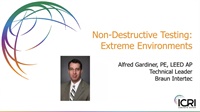
- Presenters:
- Alfred Gardiner
- Duration:
- 34 Minutes
- Format:
- Audio and Video
- License:
- Access for 6 month(s) after purchase.
- Short Description:
- Two projects will be explored in this presentation. The first is a concrete structure which for 20 years was exposed to extreme heat. The second is a structure which was exposed to extreme vibrations. Both these structures were integral parts of manufacturing processes and required limited down time to repair. The questions needing to be answered were: what is the condition of the existing concrete and what are the repair options for these structures. We turned to non-destructive techniques to evaluate these structures. Non-destructive techniques can provide insight into structures when accompanied by experienced engineers and petrographic analysis. Repair options were provided at the end of our evaluation leading to reduced down time and well-planned repairs.
- Price:
- $0.00 - Base Price

- Presenters:
- Andrew S. Fulkerson
- Duration:
- 15 Minutes
- Format:
- Audio and Video
- License:
- Access for 6 month(s) after purchase.
- Short Description:
- The demonstration will cover the use of MAPEI’s high alkaline corrosion inhibitor, Mapefer 1K and encapsulation of the repair area with Planitop 12 SR. Planitop 12 SR is a versatile, sulfate resistant, fiber-reinforced, with silica fume and corrosion inhibitor that can be applied by hand, pump, or spray on horizontal and vertical surfaces. Demonstration will show how to utilize these products in accordance with ACI Repair Application Procedures (RAP) 3, 6, and 7 as well as ICRI Guideline Nos. 310.1R and 310.2R. Demonstration will showcase a project where Planitop 12 SR was recently used to repair a Wastewater Treatment Tank.
- Price:
- $0.00 - $5.00

- Presenters:
- Mr. Matt Minney
- Duration:
- 14 Minutes
- Format:
- Audio and Video
- License:
- Access for 6 month(s) after purchase.
- Short Description:
- This demonstration video will provide information and details from Commercial and Healthcare projects for scheduling, materials, manpower, methods and protection measures necessary for the installation of a moisture vapor control (MVC) system along with self-leveling underlayments (SLU) for floor finish preparation and protection.
- Price:
- $0.00 - $5.00

- Presenters:
- Alex Daddow | Mr. Thomas Klisiewicz
- Duration:
- 13 Minutes
- Format:
- Audio and Video
- License:
- Access for 6 month(s) after purchase.
- Short Description:
- The FRCM externally bonded Composite Strengthening Systems repair and reinforcement solution combines high-performance sprayable mortar with a carbon-fiber grid that creates a thin structural layer without significantly increasing the structure's weight or volume. With FRCM, contractors can effectively repair, protect, and strengthen concrete and masonry structures in a single application for a fraction of the installed cost of traditional shotcrete.
- Price:
- $0.00 - $5.00

- Presenters:
- Mr. Khaled El-Domiaty | Kenneth McAllister White
- Duration:
- 10 Minutes
- Format:
- Audio and Video
- License:
- Access for 6 month(s) after purchase.
- Short Description:
- This demonstration will highlight the various product forms that can be integrated in a retrofit solution for extreme loading, that the product utilizes existing retrofit construction implementation practices and provides a lighter-weight retrofit solution when compared to retrofits that utilize standard or high-strength concrete solutions, and has superior multi-threat mitigation performance when compared with other concrete retrofit mitigation solutions for extreme loading events.
- Price:
- $0.00 - $5.00

- Presenters:
- George Reedy | Trevor Foster
- Duration:
- 10 Minutes
- Format:
- Audio and Video
- License:
- Access for 6 month(s) after purchase.
- Short Description:
- This demonstration covers MiraGard Granite, a water-based dual component, self-crosslinking acrylic resin binder specifically designed for use as a decorative vinyl flake broadcast system to simulate the depth and texture of natural granite stone. The product is moisture vapor permeable and can be used as a beautiful decorative topcoat over new concrete or existing concrete needing repairs whether exterior, interior, slabs-on-grade or elevated slabs. It is also rapid curing and can be completed in one day with fast return to service typically in as little as only 24 hours, and offers outstanding durability and wear resistance, UV stable for superior color retention and weathering resistance, good resistance to moisture absorption, environmentally friendly and VOC compliant and water-based for easy clean-up.
- Price:
- $0.00 - $5.00

- Presenters:
- Douglas Adam
- Duration:
- 14 Minutes
- Format:
- Audio and Video
- License:
- Access for 6 month(s) after purchase.
- Short Description:
- Hands-on application of leak repair and surface applied waterproofing products.
- Price:
- $0.00 - $5.00

- Presenters:
- Kelton Glewwe
- Duration:
- 12 Minutes
- Format:
- Audio and Video
- License:
- Access for 6 month(s) after purchase.
- Short Description:
- This demonstration will show the repair of cracks in concrete using structural polyurethane injection without pumps, ports or cutting, featuring Roadware 10 Minute Concrete Mender and Easy Injection System. This no cutting method generates almost no dust making silica dust mitigation much easier.
- Price:
- $0.00 - $5.00

- Presenters:
- Mr. Jay Patel | Stephen Hermanson
- Duration:
- 10 Minutes
- Format:
- Audio and Video
- License:
- Access for 6 month(s) after purchase.
- Short Description:
- This will be a side by side demonstration of a Master Builders Solutions low dust product versus a standard industry available product.
- Price:
- $0.00 - $5.00

- Presenters:
- Brad Nesset | John Heseltine, General Manager
- Duration:
- 10 Minutes
- Format:
- Audio and Video
- License:
- Access for 6 month(s) after purchase.
- Short Description:
- Grout-filled socks combined with threaded bars are gaining popularity to form a strong chemical and mechanical bond for securing external walls to hollow concrete floor slabs, for stitching cracked solid and multi-lead walls, for stabilizing rubble-filled walls, and securing unstable parapet walls and arches. This technology is ideal where high levels of performance are required in bending for heavy duty, high load applications. The demonstration session will provide an overview of this fast, efficient, proven installation technique.
- Price:
- $0.00 - $5.00
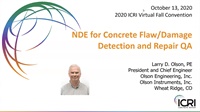
- Presenters:
- Mr. Larry D. Olson
- Duration:
- 41 Minutes
- Format:
- Audio and Video
- License:
- Access for 6 month(s) after purchase.
- Short Description:
- The case-histories based presentation will focus on the use of nondestructive evaluation (NDE) methods to detect flaws and damage in concrete construction. Case histories will be presented for detection and mapping of flaws and damage in concrete such as cracking, delamination, honeycomb, void, corrosion, fire damage, alkali-silica reaction and low strength concrete. The case histories for the concrete structures are anticipated to include parking structures, bridges, buildings and dams. NDE methods will include sonic/ultrasonic, infrared thermography, radar and corrosion technologies where the results in many cases were confirmed by coring. The use of some of the NDE methods for QA of concrete repairs such as epoxy injection and patching will also be discussed.
- Price:
- $0.00 - Base Price

- Presenters:
- Mr. Ryan Hall | Mr. Eric Muench
- Duration:
- 14 Minutes
- Format:
- Audio and Video
- License:
- Access for 6 month(s) after purchase.
- Short Description:
- Sikalastic One Shot products, Sikalastic-720 One Shot & Sikalastic-726 Balcony One Shot, will be demonstrated. Sikalastic One Shot products are an innovation in traffic coating membranes that replace the need for a base coat and multiple top-coats in a single step. These products re-imagine how traffic coating systems are designed with a polyurethane resin that has both a flexible crack-bridging ability and is extremely durable. Sikalastic-720 One Shot is a one coat system of 45 mils with a proprietary aggregate blend designed for vehicular traffic. Sikalastic-726 Balcony One Shot is a primer-less single step polyurethane system of 35 mils with a proprietary integral texture designed for balconies and pedestrian traffic....
- Price:
- $0.00 - $5.00

- Presenters:
- Stephen Scarpinato
- Duration:
- 11 Minutes
- Format:
- Audio and Video
- License:
- Access for 6 month(s) after purchase.
- Short Description:
- Three precision epoxy grouts: E3-Deep Pour, E3-Xtreme and E3-Flowable will be demonstrated. These products are precision grouts used to support equipment and machinery in demanding environments. The demonstration will explain why and where epoxy grouts are used, how they are tested, project preparation, mixing and application, and other considerations. The features and benefits of each product will be described, and newly patented dust-limiting aggregate technology will be introduced.
- Price:
- $0.00 - $5.00

- Presenters:
- Dave Pennington | Greg Rinke
- Duration:
- 30 Minutes
- Format:
- Audio and Video
- License:
- Access for 6 month(s) after purchase.
- Short Description:
- Demonstration will show what an acceptable CMU substrate for application of air barrier materials looks like, how to prepare Sprayable Cat 5 air barrier coating for application, discuss proper pump specifications for spraying the material, and demonstrate best practices for spraying Sprayable Cat 5, a Silyl-Terminated Polymer air barrier to a CMU substrate, while providing “tips & tricks” along the way.
- Price:
- $0.00 - $5.00

- Presenters:
- Danny Carrillo
- Duration:
- 11 Minutes
- Format:
- Audio and Video
- License:
- Access for 6 month(s) after purchase.
- Short Description:
- Preparation and repairs of dilapidated concrete structures, such as manholes, concrete walls, and concrete bridge structures will be demonstrated.
- Price:
- $0.00 - $5.00

- Presenters:
- Michael Murphy | Roy Cannon
- Duration:
- 17 Minutes
- Format:
- Audio and Video
- License:
- Access for 6 month(s) after purchase.
- Short Description:
- The recommended application methods utilized to successfully install Pecora Deck HB1000, a two-part polyurethane traffic coating, will be demonstrated. Demonstration and discussion will include primers, waterproofing base coats, and high-build, UV resistant topcoat.
- Price:
- $0.00 - $5.00